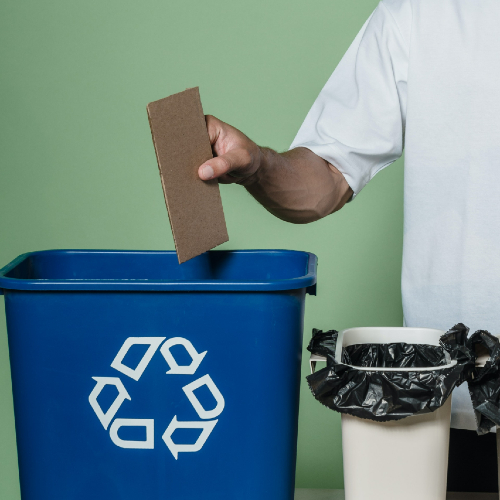Recycling Behaviors at Work
Create recycling success in your workplace. Improve recycling behaviors at work with just a few easy steps.

A business purchases recycling containers and places them throughout their building along with some signs. Sometimes, there isn't much planning or thought about the process of purchasing or placing bins. It?s just expected that recycling will work on its own. When it doesn?t, the company leaders believe that recycling just doesn?t work or won?t work for their company.
Good news! There is a proven method for making sure a recycling program works at your company, school or organization. Scientists have been studying recycling behavior for over 25 years and they have discovered what works and what doesn?t.
[video] See tips for workplace recycling.
Here's how to make recycling work at your place of employment:
How to Create Success & Why it Works
Convenience.
Purchase appropriate recycling containers and place them in convenient places ? under desks, besides the copy machine, at entrances and exits to conference rooms, in the lunch or break room. Anticipate the flow of traffic throughout the buildings. Recycling must be easy to do in order to get the best participation.
Clarity and uniformity.
The recycling bins must all be the same color, preferably blue or green, and the signs must be clearly marked on the bin all to avoid confusion. A second sign should be placed above the bin.
Consider this: You are traveling through multiple cities. In city #1, all of the stop signs are red. In city #2, all of the stop signs are orange and, in city #3, all of the stop signs are blue! Well, that?s confusing!
The same is true for bin color. The signs must have clear photos and very few words. If the bins are for mixed recycling, try to post photos of the most anticipated items rather than filling the signs with too many images.
Also, trash containers must all be the same color, preferably black, brown or gray. A trash can must be placed next to each recycling bin so the trash and recycling containers are ?married? to each other. Employees will not visit one side of the room for recycling and then go to the other side to dispose of trash. That?s not convenient.
Make the trash can smaller than the recycling container to imply that you should produce less trash than recycling. Use clear bags or no bags in the recycling bins and use black or grey bags for the trash bins. Specific bag colors makes it easier for the facility people collecting the trash and recycling to put it in the right containers.
Use the label ?Landfill? instead of ?Trash? whenever possible. The word ?Landfill? causes people to think about what they are throwing out and where it will go. People are accustomed to seeing the word ?trash? and believe that when you throw it in the trash it goes away. There is no such thing as ?away.? Having bins that are clearly labeled will reduce contamination and promote the production of less trash and more recycling.
Use the side cars or ?mini? trash cans attached to the recycling bin. Recyclables usually won?t fit in those mini trash cans.
Don?t just use the word ?Plastic? on a sign. It has too many meanings and invites contamination. Anything from plastic bags to bottles to plastic wrap will be thrown in the bin. Instead, use specific language such as ?Plastic Bottles and Containers? or ?Plastic Bottles and Jugs? or ?Plastic Bottles? depending upon what you want in the bin.
Do not use the term "Aluminum" on the signs. You will get aluminum foil, disposable aluminum pans, pie tins and other metal in the container. Use the words "Aluminum Cans" or "Cans" depending on the items you want to collect.
Continual recycling education is necessary.
Placing containers and signs out with no explanation may result in some recycling, but a ?kick-off? Lunch and Learn for employees or a staff meeting on the new program will result in better cooperation. Provide food or lunch as an incentive to encourage attendance at the meeting.
Education needs to be constant to reinforce new behaviors. Ask for employee suggestions on how to make the program more convenient and successful. Include input from facilities management on the most effective way to collect the materials and have them picked up.
Post recycling program details on bulletin boards, television screens in lobbies or elsewhere, emails, newsletters, in the employee manual and make it a part of onboarding of new employees.
Celebrate success and communicate what is being recycled and how much is being recycled. If possible, relate it to how many trees were saved, how much water was saved and how much energy was saved. Do another recycling and waste audit 4-6 months later to check the success of your program and make adjustments as necessary.
Ask for help or assistance.
Attend a free educational seminar or roundtable discussion about workplace recycling. What worked for your company when you launched your waste reduction and recycling program? What didn?t work and why? Hear about successes and failures while learning from others.
Have an online discussion about recycling at work. Follow the District on LinkedIn for regular tips on recycling at work and school.
Our staff can help with recycling program audits, assessments and improvements. If you're a school, teacher or educator, contact Carin Miller at (216) 443-3731 or by email. Businesses and other organizations can contact Doreen Schreiber at (216) 443-3732 or by email.
